Every June, locals stage a mesmerising event that’s become a cultural staple for the town of Campobasso in Molise, writes Val Nicastro…
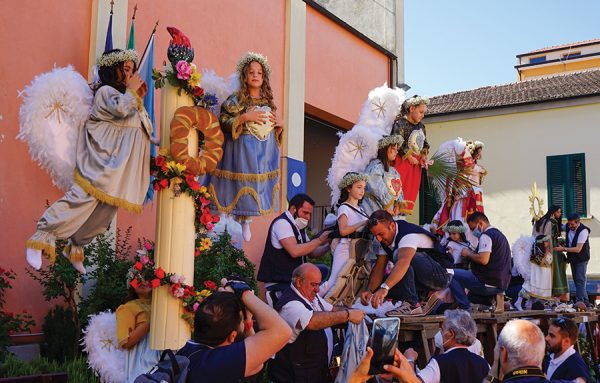
Here I am sitting at a table with complete strangers I only met five minutes ago while looking out of the window of my B&B. They gestured for me to join their little dinner party and are now feeding me beautiful food and wine accompanied by laughter and good music. This makes it click that something amazing is about to happen.
It’s the Saturday evening before the Festival of the Mysteries, the most important event of the year in Campobasso, and the capital of Molise is buzzing with excitement and anticipation.
The main piazza is filled with stalls selling artisanal goods and local specialities, like mussillo (boiled veal face with salt and lemon), nocelle (peanuts), and the legendary panino zozzo – which, despite its name (literally, dirty sandwich), is heaven.
People get together and stay out until late, anxiously waiting for the first light of Sunday, because that’s when the magic happens.
The Festival of the Mysteries
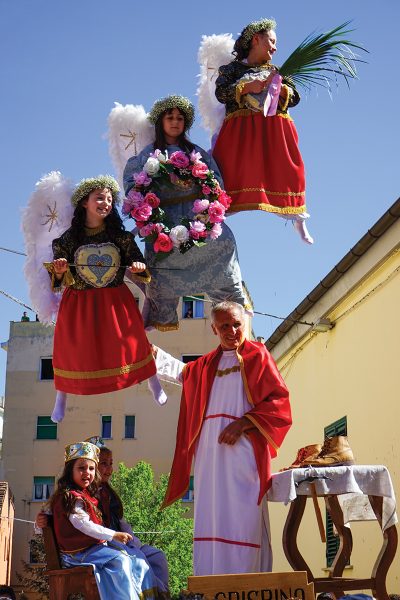
The Festival of the Mysteries is a grand procession of thirteen scenes from the Old and New Testaments that parades through the streets of Campobasso on the Sunday of Corpus Christi in June.
It might sound fairly tame, but that’s only until you see children floating in the air and a devil sinking his teeth into a calf’s tail.
This event is unique in so many ways. For a start, in place of the usual statues, there are adults and children portraying biblical characters anchored to special machines dating from the 18th century.
There’s Saint Anthony the Abbot battling against the devil’s temptations, Abraham about to kill his child Isaac, Saint Michael pushing Lucifer to hell, and many others.
Moreover, each machine is designed so the kids look like they are flying – quite a sight!
But to me, the most fascinating aspect of this festival, which has been a fixture on the town’s calendar for nearly three centuries, is the sense of pride and unity it fosters. Seeing the locals’ eyes light up when they talk about the Mysteries shows you how special this event is to the community.
Through its history, this showcase of folklore, religiosity, and popular devotion has drawn the attention of many illustrious figures, including Ferdinand II of Bourbon.
It is said that during his visit to Campobasso in 1832 he was so enthralled by these machines that he declared he’d move the festival to Naples if the parade didn’t happen one year.
Luckily for Campobasso, this never happened, despite the stops during the second world war and the Covid-19 pandemic.
The unique processional structures used during the festival are the genius work of Paolo Saverio Di Zinno, a local sculptor.
In 1748 he came up with the idea of animating traditional sacred representations by replacing statues and paintings with humans. He created these special shoulder-borne machines – known as ingegni – with a secret alloy of iron and metal that makes them light and flexible but also extremely strong.
Each structure has a wooden base with a central axis that develops vertically, and secondary branches with harnesses at each end to which children are secured.
Costumes and props conceal the harnesses, giving the illusion that children are suspended in the air. The great elasticity of the structure causes oscillations, adding to the illusion.
Originally there were eighteen machines, but only twelve of those have survived to this day because six were destroyed in the terrible Molise earthquake of 1805.
In 1959, a thirteenth ingegno – representing the Love of Jesus for Humanity – was realised based on a drawing by Di Zinno, and today this is the one that closes the parade.
The big day
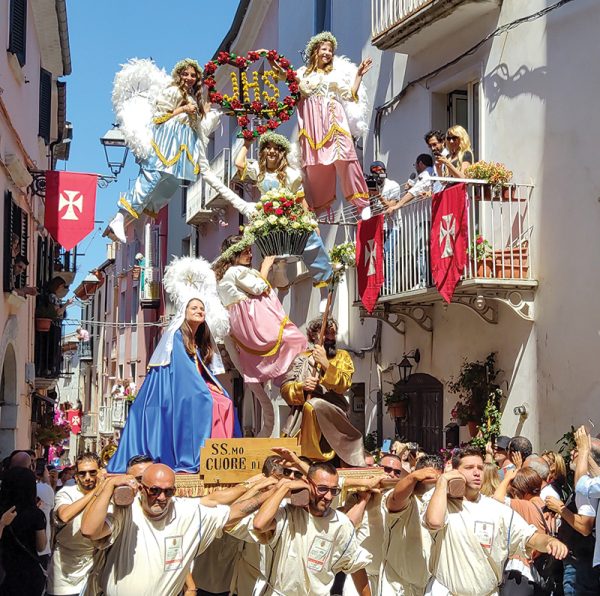
On Corpus Christi Sunday, actors and bearers gather at the Museum of the Mysteries at dawn to prepare for their big day on parade.
At 8:00am the local archbishop celebrates mass in the courtyard, and then the dressing ceremony starts. Each ingegno is placed on a trestle, with two dressers taking responsibility for securing the children to their harnesses and helping them get dressed.
Watching each biblical scene come to life from a bare structure is a truly fascinating experience. Even more amazing is watching the kids’ excitement when they ask their parents if they look good in their costumes and if their nonni are there to see them.
Then, at 10:00am sharp, a voice shouts “Scannétt allért, uno, due, tre!” (Trestle ready, one, two, three). That’s the signal that initiates everything: trestles are removed and the parade officially kicks off, to thunderous applause.
It takes teams of twelve to twenty bearers to carry each of the thirteen machines, which are up to six metres tall and weigh about half a tonne. The rhythm and pace of the procession is marked by five bands playing Rossini’s Mosè in Egitto and each Mystery has a team leader who sets the pace and coordinates temporary stops along the four-kilometre route.
When the Mysteries pass through the tiny alleys of the centro storico people on their balconies throw sweets to the children, and some hand a cup of coffee to the devils.
A touching moment during the procession is when the parade stops at Di Zinno’s house and the bands play Il Silenzio in honour of his ingenuity.
Then, at around 1pm, the thirteen Mysteries line up in front of the Town Hall to receive the holy blessing from the archbishop before making their way back to the museum, where the procession ends.
The Devils and the Tunzella
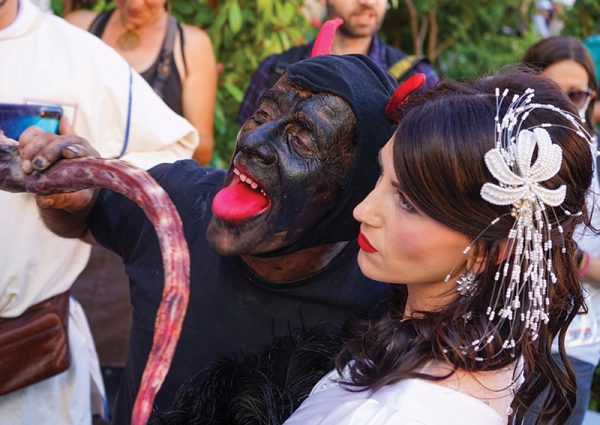
Every character is beautiful to watch, but the devils and the tunzella, the damsel in the Mystery of Saint Anthony the Abbot, steal the show.
I’ve been told that the tunzella is the devil disguised as a woman to lure the saint into sin. However, the fact that she must show utmost seriousness throughout the parade and not laugh at the devils’ jokes is more generally considered symbolic of her being strong against temptation.
The devils, dressed entirely in black, are the only characters who can interact with the public, mocking them and showing off their red tongues as they shout “Tunzella, tunzella… vietenn, vietenn” (Damsel, damsel… come with me, come with me).
There’s a mad rush to take a selfie with them (including me, I confess), and mothers elbow their way through the crowds to hand their babies so they can be “baptised” with the devils’ black ink.
Preparing for the Festival of the Mysteries
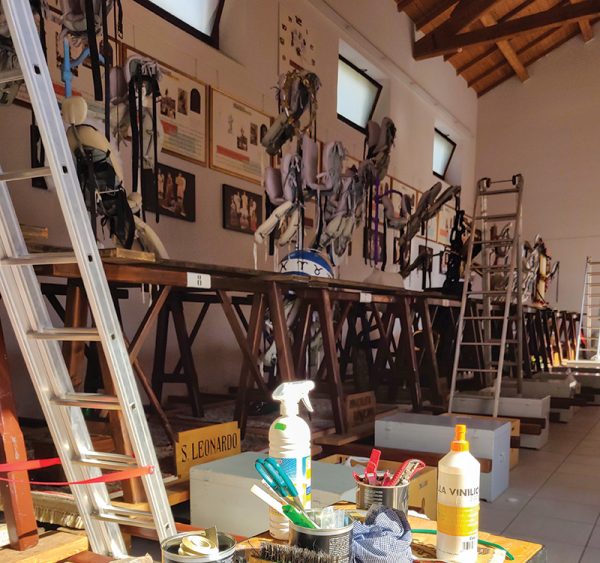
Preparations for the procession start months before the festival. There’s a lot to do, like inspecting the machines, dusting off the costumes and recruiting characters.
Only seventy-four spots are available on the ingegni, and competition is fierce. While adults tend to maintain their roles through the years, children must be at least four and pass a height, weight, and motivation test to be considered for one of the Mysteries.
Also, they have to participate in trials to prove they are comfortable in the machines, since they’ll spend a lot of time in them during the event. All roles require good physical conditioning to stay on the machines for several hours, often under the scorching summer sun.
The most coveted role is that of the tunzella. Next are the roles for the angel in the Mystery of Abraham (the one which fluctuates the most) and the Holy Virgin in the Mystery representing the Assumption of the Blessed Virgin Mary (the highest).
Every year, many people apply for a role, and being chosen is considered a great honour, something to be proud of. But then, the beauty of this festival is that it’s a community event where everyone has a part to play, whether it’s preparing the ingegni and parading with them, or just watching and cheering. Very few times before have I seen such an involvement.
The Museum of the Mysteries
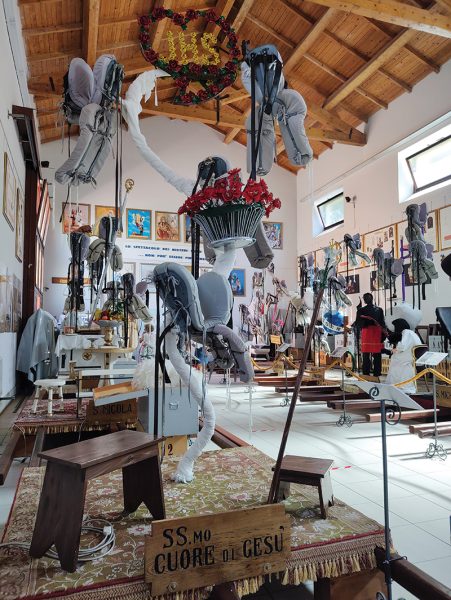
Throughout the year, this precious heritage of popular and religious culture is displayed at the local Museum of the Mysteries.
Opened in 2006, the museum consists of two exhibition halls and a projection room with vintage footage and recent videos that partly recreate the event’s atmosphere. Original period costumes are exhibited together with photographs from past events.
The heart of the museum is the ingegni room, where visitors can see Di Zinno’s thirteen machines up close and appreciate the structural and artistic peculiarities that make them unique.
Of all the many spectacular events that take place in Italy, the Festival of the Mysteries is one of the most breathtaking and really worth experiencing.
It’s a time-honoured tradition that locals look forward to for an entire year, and one that’s deeply ingrained in the identity of Campobasso – the capital of a region that doesn’t exist for many people but is, in fact, one of the most authentic, hospitable places in Italy.
Ready to take a trip? Discover the best places to stay, eat, and explore in our Campobasso guide.
All images © Val Nicastro
